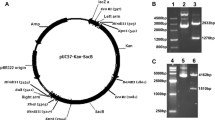Summary
A review of the data on the genetic determination of general recombination in Escherichia coli introduces three alternative pathways of recombination, RecBC, RecF, and RecBCF. One recBC-dependent pathway is functional in recF − cells. An initiating endonuclease is involved, acting on the chi-sites of DNA. The second is recF-dependent, acting in the double mutant recBC sbcB. The corresponding endonuclease uses the fre-sites as a substrate. A third pathway acting in wild-type cells is mixed. Both enzymatic systems participate in the overall process. We shall call it RecBCF.
Using the thermosensitive recA44 mutant it became possible to study the kinetics of integration of donor DNA into the recipient chromosome via the RecF and RecBCF pathways of recombination. The RecF pathway is characterized by delayed recombination; not less than 14 h being needed to complete the process at 35° C. By the RecBCF pathway (wild-type recipient) the reaction is fast, as described by Lloyd and Johnson (1979). The two stage nature of the RecF pathway is important. First an intermediate product is formed during a short time interval. This product is resistant to the degrading exonuclease V. Afterward the intermediate product is slowly integrated into the recipient chromosome. Autoradiography of this intermediate product, extracted from exconjugants, shows that it consists of closed DNA circles. Their length is within the limits 2–15 min on the E. coli map. Their average value is in fair agreement with genetic estimations of the integrated DNA fragments.
Taking into consideration the similarity between genetic determinations of the fre-effects and the heterogeneity of the progeny, we conclude that the intermediate structures formed contribute to this heterogeneity.
Similar content being viewed by others
References
Bergmans HEN, Hoekstra WPM (1977) The fate of the donor DNA after conjugation in Escherichia coli K-12: influence of the growth rate of the recipient. Mol Gen Genet 158:179–183
Bresler SE, Goryshin IYu, Lanzov VA (1980) Intermediate DNA structures formed during recombination after conjugation in Escherichia coli K-12. Reports Acad Sci USSR 251:717–720
Bresler SE, Krivonogov SV, Lanzov VA (1978) Scale of the genetic map and genetic control of recombination after conjugation in Escherichia coli K-12. Hot spots of recombination. Mol Gen Genet 166:337–346
Bresler SE, Krivonogov SV, Lanzov VA (1979) Genetic determination of the donor properties in Escherichia coli K-12. Phenomena of chromosome mobilization and integrative suppression. Mol Gen Genet 177:177–184
Bresler SE, Krivonogov SV, Lanzov VA (1981a) Site-specific nature of recombination and the possibilities of rejection of hot sites. Reports Acad Sci USSR 257:1466–1469
Bresler SE, Krivonogov SV, Lanzov VA (1981b) Recombinational unstability of F′ plasmids in Escherichia coli K-12. Localization of fre sites. Mol Gen Genet (in press)
Bresler SE, Lanzov VA, Blinkova AA (1967) Mechanism of genetic recombination during conjugation in Escherichia coli K-12. I. Heterogeneity of the progeny of conjugated cells. Genetics 56:105–116
Bresler SE, Lanzov VA, Manukjan LR (1970) Clonal analysis of the progeny of exconjugants bearing a system of close genetic markers. Genetics USSR 6:116–134
Cairns J (1963) The bacterial chromosome and its manner of replication as seen by autoradiography. J Mol Biol 6:208–213
Chattoraj DK, Crasemann FW, Stahl MM (1979) Chi. Cold Spring Harbor Symp Quant Biol 43:1063–1066
Clark AJ (1974a) Recombination deficient mutants of Escherichia coli and other bacteria. Ann Rev Genet 7:67–86
Clark AJ (1974b) Progress toward a metabolic interpretation of genetic recombination of Escherichia coli and bacteriophage lambda. Genetics 78:259–271
Deonier RC, Mirels L (1977) Excision of F plasmid sequences by recombination at directly repeated insertion sequences 2 elements: involvement of recA. Proc Natl Acad Sci USA 74:3965–3969
Faulds D, Dower N, Stahl MM, Stahl FW (1979) Orientation dependent recombination hotspot activity in bacteriophage λ. J Mol Biol 131:681–695
Goryshin IYu, Lanzov VA (1977) Single-stranded conjugation: peculiarity of the formation of heterogeneous progeny. Genetics USSR 13:1246–1251
Hopkins JD, Clement MB, Liang TY, Isberg RR, Syvanen M (1980) Recombination genes on the Escherichia coli sex factor specific for transposable elements. Proc Natl Acad Sci USA 77:2814–2818
Khachatourians GG, Paterson MC, Sheehy RJ, VanDorp B, Worthy TE (1975) DNA degradation in minicells of Escherichia coli K-12 II. Effect of recA1 and recB21 mutations on DNA degradation in minicells and detection of exonuclease V activity. Mol Gen Genet 138:179–192
Lloyd RG, Johnson S (1979) Kinetics of recA function in conjugational recombinant formation. Mol Gen Genet 169:219–228
Lotan D, Yagil E, Bracha M (1972) Bacterial conjugation: an analysis of mixed recombinant clones. Genetics 72:381–391
Mackay V, Linn S (1976) Selective inhibition of the DNAase activity of the recBC enzyme by the DNA binding protein from Escherichia coli. J Biol Chem 251:3716–3719
Mahajan SK, Datta AR (1979) Mechanism of recombination by the RecBC and RecF pathways following conjugation in Escherichia-coli K-12. Mol Gen Genet 169:67–78
Malone RE, Chattoray DK, Faulds DH, Stahl MM, Stahl FW (1978) Hotspot for generalyzed recombination in the Escherichia coli chromosome. J Mol Biol 121:473–491
Ou JT, Kuo LM (1979) Suppression of the formation of polygenotypic recombinant colonies by a maf mutation in mating with Hfr H. Genetics 93:345–351
Ou JT, Wood TH (1973) Kinetics of genetic recombination in Escherichia coli K-12: competition between genetic integration and degradation. Genetics 75:579–592
Rosamond J, Telander KM, Linn S (1979) Modulation of the action of the recBC enzyme of Escherichia coli K-12 by Ca2+. J Biol Chem 254:8646–8652
Stahl FW (1979) Special sites in generalyzed recombination. Ann Rev Genet 13:7–24
Author information
Authors and Affiliations
Additional information
Communicated by D. Goldfarb
Rights and permissions
About this article
Cite this article
Bresler, S.E., Goryshin, I.Y. & Lanzov, V.A. The process of general recombination in Escherichia coli K-12. Molec. Gen. Genet. 183, 139–143 (1981). https://doi.org/10.1007/BF00270152
Received:
Issue Date:
DOI: https://doi.org/10.1007/BF00270152




